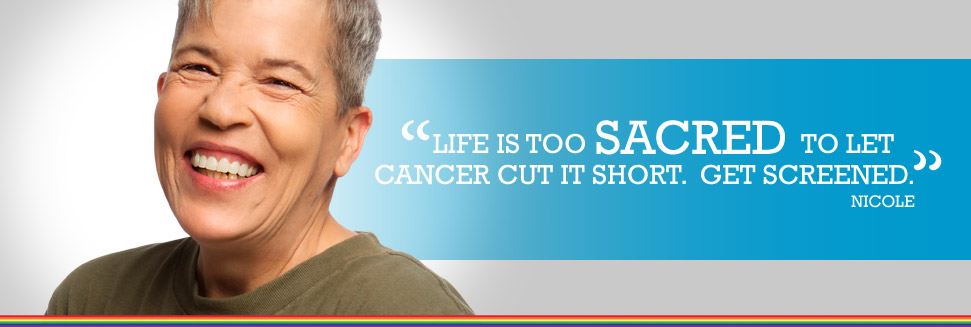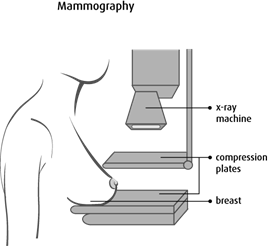
The screening test
Mammograms are the best tool for early detection of breast cancer. A low-dose x-ray machine takes detailed images of breast tissue from different angles. The images help determine if there is any abnormal growth occurring in your breast tissue.
Lumps and other changes can be detected by a mammogram even if they are too small to be felt by a hand. That’s why it’s important to get screened regularly—screening means finding abnormalities early, when they are easiest to deal with.
Who should get screened?What happens during the mammogram?
Does it hurt?
How do I prepare for the test?
How can I make a mammogram more comfortable physically and emotionally?
How do I book a mammogram?
How will I get the test results?
Who should get screened?
Early detection helps fight breast cancer. While not every lump is cancerous, your chances of getting breast cancer increase once you’re 50. So you should get regular mammograms every two years once you turn 50.
And no matter how old you are, become familiar with your breasts and talk to your healthcare professional if you notice any changes. Many women are alive and well today because their breast cancer was detected and treated early.
The Canadian Cancer Society recommends the following breast cancer screening guidelines:
| If you are: | You should: |
|---|---|
| 40 to 49 | Talk to your doctor about your risk of breast cancer, along with the benefits and risks of mammography. |
| 50 to 69 | Have a mammogram every 2 years. |
| 70 or older | Talk to your doctor about how often you should be checked for breast cancer. |
What happens during the mammogram?
Screening mammograms are done in a clinic or screening centre. Mammograms show detailed images and views of the breast taken from different angles.
When you have a mammogram, the breast is placed between two plastic plates. A registered medical radiation technologist will place your breast on the plastic plate of the mammography unit that will be adjusted to your height. A second plate will press down on your breast for a few seconds to spread out the breast tissue. Compressing the breast tissue helps make the images clearer while using as little radiation as possible. This will not harm your breast tissue.
Two x-rays are taken of each breast, one from the top and one from the side. The technologist will make sure that the pictures are good enough quality for the radiologist to read and will take more pictures if necessary. The X-rays are then examined by a radiologist to determine if there are any abnormal changes. For most people, it takes less than ten minutes to get a mammogram.

Does it hurt?
You may have heard that getting a mammogram can be painful or uncomfortable, because to get the x-ray pictures you have to have your breasts placed between two compression plates, which flatten the breast.
This is done to make sure the images are clear and that the smallest amount of radiation possible is used when taking the x-rays. You will feel some pressure on your breasts for just a few seconds - it feels a lot like a tight blood pressure cuff. For some people, this can be uncomfortable or outright painful, but it should only last a few seconds. If it lasts longer than that, you can tell the technician and they can adjust the compression.
How do I prepare for the test?
When getting ready for your mammogram, do not apply any deodorant, lotions or talcum powder on the day of the test. The metals in these products can interfere with the x-ray. It is also helpful to not wear anything that can get in the way of the test for example, jewelry such as necklaces or clothing that is difficult to remove from the waist up.
How can I make a mammogram more comfortable physically and emotionally?
- If you get periods, try to avoid scheduling your appointment 7-10 days before the start of your next period; breasts tend be more tender at this time.
- Avoid drinks and food such as cola, coffee and chocolate for 5-7 days before your mammogram or ultrasound. They contain caffeine and may cause added discomfort from fluid retention.
- Call the screening centre ahead of time to speak to a booking clerk, receptionist or technician about what practices are in place to make the reception area, changing room, waiting area and procedure as stress free as possible for you. You can also ask about how they will accommodate any of your access needs.
- Have a supportive friend attend the appointment with you.
- Wear separates for your clothing, with a top and a bottom, so that you only have to remove your top for the screening.
- For some LGBTQ people, being out to our doctor is important to getting the health care that we need. To others, it can make getting adequate health care more difficult, because of the fear of experiencing homophobia/transphobia and or provider misinformation. Coming out is your personal decision.
- Ask your health care provider to walk you through the process of getting a mammogram before it starts. They can tell you what they will be doing step by step.
- Prior to the test, let the health care provider know what you will need in order to make your test more comfortable. For example, if it’s difficult for you to be touched in a certain place, or if you would like your body parts to be called by a different name.
How do I book a mammogram?
Getting a mammogram is free for Ontario residents. There are two ways to book a mammogram:
- You can book one yourself through the Ontario Breast Screening Program (OBSP)
- Visit your family doctor to get a referral for a mammogram
The Ontario Breast Screening Program (OBSP) provides high quality breast cancer screening for females who are both average and high risk. Getting a mammogram through OBSP has many advantages:
- You don’t need a referral from your family doctor. You can call up your local OBSP site and book your own appointment.
- High-quality mammograms are ensured at all sites. All OBSP sites have been accredited by the Canadian Association of Radiologists.
- You get your test results within two weeks of your screening.
- You will get support to set up extra tests or referrals if your results say that you need them.
- You will get a reminder letter when it’s time for your next mammogram, usually every two years.
Eligibility for the Ontario Breast Screening Program
If you’re at average risk, you’re eligible for OBSP screening if you:
- are assigned female on your health card
- are 50 years old or older
- have no acute breast symptoms
- have no personal history of breast cancer
- have no current breast implants
If you’re at high risk for breast cancer, you’re eligible for OBSP screening if you:
- have a referral from your physician
- are between 30 and 69 years of age
- have no acute breast symptoms (e.g.: a lump, abnormal discharge, etc.)
- fall into one of the following risk categories:
- you have a genetic mutation that puts you at a higher risk for breast cancer
- you have a parent, sibling or child who has a genetic mutation that puts you at a higher risk for breast cancer
- you have a family history that indicates a lifetime risk of breast cancer that is great or equal to 25% confirmed through genetic assessment
- you have received radiation therapy to the chest before 30 years of age as treatment for another cancer or condition (e.g., Hodgkin’s disease).
You can book a mammogram yourself by contacting an OBSP site directly. Find your nearest screening facility that meets your access needs. Or you can call their toll free line at 1-800-668-9304 and send questions to breastscreen@cancercare.on.ca.
Visit your family doctor to book a mammogram
If you aren’t eligible for the Ontario Breast Screening Program, you can still get a mammogram by getting a referral from your family doctor.
If you don’t have a family doctor, call Telehealth Ontario at 1-866-797-0000, TTY: 1-866-797-0007 or Health Care Connections at 1-800-445-1822 to help you find one.
To ensure that you get a good quality mammogram, make sure that the screening site you’re visiting has been accredited by the Canadian Association of Radiologists Mammography Accreditation Program by visiting car.ca. You can also call the Canadian Cancer Society Cancer Information Service at 1-888-939-3333 to find out if your screening site is up to par.
How will I get the test results?
After a radiologist has examined your x-rays, you will find out about your test results in the following ways:
- if you were referred by your family doctor, your doctor will hear from the screening site and communicate that information to you.
- if you were screened through the Ontario Breast Screening Program, and your test results were normal, you will get your test in the mail two weeks after your mammogram. Your doctor will receive a copy of the letter as well.
- if you were screened through the Ontario Breast Screening Program and your test results were inconclusive or further testing is required, you will get a phone call from the program two weeks after your mammogram. Your doctor will receive the results as well.
Getting test results back is often nerve-wracking. It’s important to take care of yourself when you are finding out the results. Consider calling a friend, family member or partner to open the letter with you.
If your test results are negative, this means that no signs of breast cancer were found. Most people have a normal result after screening. You will receive a letter in two years reminding you that it is time to get a mammogram again.
If your test results are positive, this means that there are signs of breast cell abnormalities. While this may be scary, it’s important to remember that most women needing further tests do not have breast cancer. Follow up testing is required to find out more information about the abnormalities. You will find out what follow up testing is required through your doctor, and testing appointments will be made either by your doctor or through OBSP staff.
